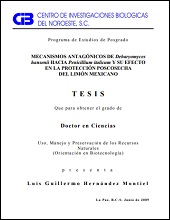Mostrar el registro sencillo del ítem
Mecanismos antagónicos de Debaryomyces hansenii hacia Penicillium italicum y su efecto en la protección poscosecha del limón mexicano
| dc.contributor | ENRIQUE TROYO DIEGUEZ | |
| dc.creator | LUIS GUILLERMO HERNANDEZ MONTIEL | |
| dc.date | 2009-06-30 | |
| dc.identifier | http://cibnor.repositorioinstitucional.mx/jspui/handle/1001/314 | |
| dc.identifier.uri | http://dspace.cibnor.mx:8080/handle/123456789/2244 | |
| dc.description | Se identificó a nivel molecular a Penicillium italicum como el agente causal del moho azul en frutos de limón mexicano provenientes del Estado de Colima, México. Para el control biológico de dicho hongo patógeno en poscosecha, se utilizó una colección de doce levaduras Debaryomyces hansenii, las cuales fueron caracterizadas in vitro para determinar su capacidad de competencia por espacio y nutrimentos, producción de enzimas hidrolíticas y toxinas killer, finalmente se evaluó su protección sobre frutos de limón. Las levaduras LL1, LL2 y LL3 fueron las más efectivas para el control in vitro del moho azul en medios elaborados a base de limón mexicano y PDA. En la competencia por nutrimentos provenientes del limón, estas levaduras epífitas fueron las que asimilaron rápidamente las fuentes de sacarosa, fructosa y glucosa del medio flavedo y albedo de frutos de limón, inhibiendo los niveles de germinación de las esporas de P. italicum hasta en más de un 80%. Se determinó que todas las levaduras Debaryomyces hansenii produjeron enzimas (β- 1,3 glucanasa, quitinasa y proteasa) capaces de degradar paredes celulares del hongo patógeno. El intervalo de actividad para β-1,3 glucanasa se determinó entre los 9 y 13 días de evaluación, alcanzando el máximo nivel las levaduras DhfBCS002, DhhBCS004 y DhhBCS006. Para la actividad quitinasa, el intervalo de actividad se determinó entre los 9 y 11 días y las levaduras con mayor actividad fueron la DhhBSC006 y DhhBCS003. En la determinación de proteasa, la actividad inicial se detectó a los 9 días de evaluación, donde las levaduras DhhBCS003 y DhhBCS007 mostraron su nivel más alto dentro de su cinética. Por la producción de toxinas killer se observó antagonismo in vitro de las levaduras Debaryomyces hansenii hacia P. italicum en los pHs probados, perdiendo todas las levaduras su actividad antagonista en el pH 5.4. En frutos de limón mexicano se cuantificaron diversos niveles de protección con las distintas levaduras de Debaryomyces hansenii en tres dosis de aplicación 104, 106 y 108 células mL-1 hacia la pudrición ocasionada por P. italicum [...] | |
| dc.description | Penicillium italicum was identified at molecular level as the causal agent of the blue mold decay of Mexican lemon fruits from Colima’s state, Mexico. For the biological control of postharvest blue mold decay, was used a collection of twelve Debaryomyces hansenii yeast, which were characterized in vitro to determine their capacity of competition for space and nutriments, production of lytic enzymes, killer toxins and their effect on the protection Mexican lemon fruits. The LL1, LL2 and LL3 yeasts were the most effective for the in vitro control of the blue mold decay in elaborated medium based on Mexican lemon fruits and PDA. At the competition for lemon’s nutriments, these epiphytes yeast were those who quickly assimilated the sources of sucrose, fructose and glucose from the flavedo and albedo agars from Mexican lemon fruits, disabling the levels of germination of the spores of P. italicum up to, even more than 80%. It was determined that all the D. hansenii yeast produced enzymes (β-1.3-glucanase, chitinase and protease) capable of degrading cellular walls of the pathogenic fungi. The interval of activity for β-1.3- glucanase was determinate between the 9 and 13 days of evaluation, reaching the maximum level the DhfBCS002, DhhBCS004 and DhhBCS006 yeasts. For the chitinase activity, the range enzymatic activity was determinate between the 9 and 11 days and the yeasts with major activity were DhhBSC006 and DhhBCS003. In the protease determination, the initial activity was detected at the 9 days of evaluation, where the DhhBCS003 and DhhBCS007 yeasts showed the higher level inside their kinetic. By the production of killer toxins was observed in vitro antagonism of the D. hansenii yeasts towards P. italicum at the proved pHs, losing the yeasts all their antagonist activity in the pH 5.4. In Mexican lemon fruits diverse levels of protection were quantified with the different D. hansenii in three doses of application 104, 106 y 108 cells mL-1 towards the blue mold decay caused by P. italicum [...] | |
| dc.format | application/pdf | |
| dc.language | spa | |
| dc.publisher | Centro de Investigaciones Biológicas del Noroeste, S.C. | |
| dc.rights | info:eu-repo/semantics/openAccess | |
| dc.rights | http://creativecommons.org/licenses/by-nc-nd/4.0 | |
| dc.subject | info:eu-repo/classification/AUTOR/Penicillium italicum; limón mexicano; levaduras; control biológico | |
| dc.subject | info:eu-repo/classification/cti/6 | |
| dc.subject | info:eu-repo/classification/cti/31 | |
| dc.subject | info:eu-repo/classification/cti/3108 | |
| dc.subject | info:eu-repo/classification/cti/310802 | |
| dc.subject | info:eu-repo/classification/cti/310802 | |
| dc.title | Mecanismos antagónicos de Debaryomyces hansenii hacia Penicillium italicum y su efecto en la protección poscosecha del limón mexicano | |
| dc.type | info:eu-repo/semantics/doctoralThesis |


